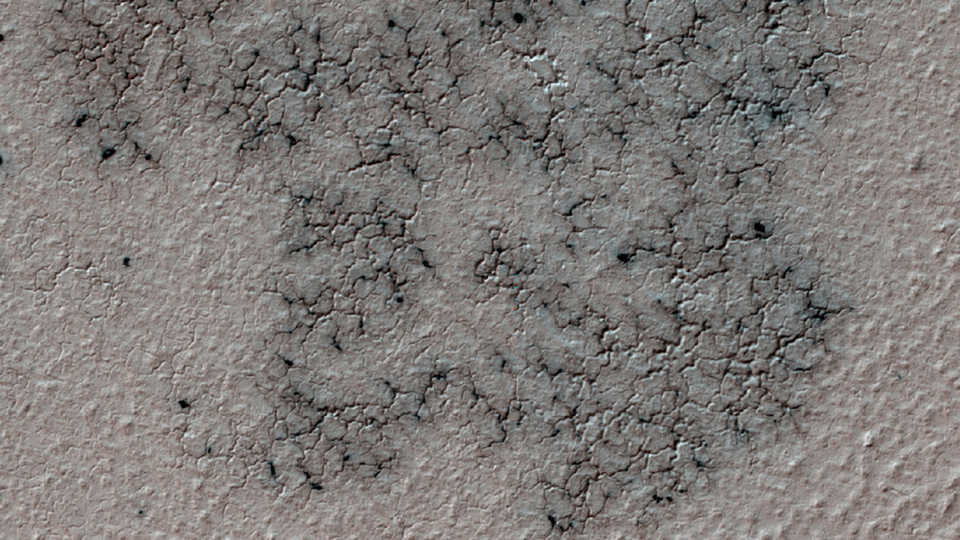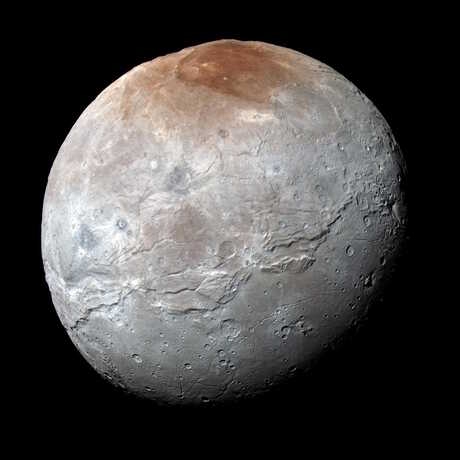Science News
Landing on Mars, Seeing Spiders on the Red Planet, and Eta Carinae

ESA's Second Mars Mission Mirrors the First: Orbiters 2, Landers 0
On Wednesday, the European Space Agency (ESA) proudly announced that after a 483 million kilometer (300 million mile) journey that lasted seven months, Earth’s latest mission to Mars reached its target. Joining a fleet of spacecraft in orbit around the Red Planet that includes NASA’s Mars Reconnaissance Orbiter, 2001 Mars Odyssey, and MAVEN, not to mention Mangalyaan, India’s Mars Orbiter Mission (affectionately known as “MOM”), this marks only the second time ESA has sent a spacecraft to Mars. However, like the first time—2003’s Mars Express mission—the orbiter got there safely, but the lander is missing in action. At that time, contact was lost with Beagle 2, the lander carried by Mars Express. Recent images taken by NASA spacecraft indicate that Beagle survived its landing, but that its petal-like solar panels had not unfolded properly, leaving the craft unable to collect enough sunlight to operate.
The current mission is called ExoMars 2016 and is a joint venture with Russia’s Roscosmos State Corporation. It consists of the Trace Gas Orbiter (TGO), which will attempt to detect methane (a potential biosignature) and other gases in the martian atmosphere, and an Entry, Descent and Landing Demonstrator Module (EDM) named Schiaparelli. Three days before orbital insertion, Schiaparelli was deployed and sent on an entry path while TGO continued on an orbital trajectory, and Wednesday morning, mission controllers celebrated as they received telemetry that indicated a successful orbit. Then, in the following hours, they waited nervously for similar signs from Schiaparelli on the surface.
They never came.
About a minute before the anticipated landing, communications abruptly ended, and after a preliminary analysis of the data received, controllers have concluded that something went awry during the landing sequence. Yet another in a string of inventive landing strategies that has ranged from retrorockets to airbags to skycranes, this sequence involved using rockets to lower the lander to a height of 2.5 meters (6 feet) above the ground. Then, the rockets would shut off, and the lander would plop to the surface at a speed of 4 kilometers (3.1 miles) per hour. A built-in crumple zone would absorb the shock of landing and protect the vehicle.
However, it seems the back heat shield encasing the lander jettisoned early, and although the landing rockets appear to have fired after heat shield separation, they unexpectedly shut off after about three seconds (they were supposed to burn for about 30), leaving the lander at an altitude of about 1.3 kilometers (0.8 mile) without power or a parachute.
Hello, gravity.
ESA officials are putting a positive spin on the apparent mishap, reminding us that TGO is successfully in orbit and that Schiaparelli was an experimental module from which much can be learned even in the face of failure. It was designed to demonstrate the capability to land on Mars, which isn't all that easy to even get to, let alone land on—about half the spacecraft sent there haven't made it.
ExoMars 2016 will be followed by ExoMars 2020, which will include a rover with its lander… If ESA can figure out the “landing” part. –Bing Quock
Citizen Scientists and the Spiders from Mars
Where should scientists look for spiders on Mars? Ten thousand citizen scientists have helped to narrow down possible locations looking at many images of the surface of the Red Planet from the comfort of their own homes.
The volunteers used Planet Four: Terrains, a Zooniverse project that features images from the Context Camera (CTX) on NASA’s Mars Reconnaissance Orbiter (MRO), to identify certain types of seasonal terrains near Mars’s south pole. “It’s heartwarming to see so many citizens of planet Earth jump in to help study Mars,” says Candice Hansen, of the Planetary Science Institute. “Thanks to the discovery power of people, we're taking pictures of features of Mars with HiRISE [MRO’s High Resolution Imaging Science Experiment camera] of places we would not have imaged without this assistance.”
Okay, before we get much farther, we should explain that these are not the arachnids from Mars that Ziggy Stardust sang about, but rather erosional features on the surface of the neighboring planet. These terrain types are called spiders or “araneiform” (from the Latin word for spiders) because they are characterized by multiple channels converging at a point, resembling long legs of a spider. Previous studies concluded this ground texture results from thawing of extensive sheets of ice bottom-side first as the ice is warmed by the ground underneath. Thawed carbon dioxide gas builds up pressure underneath. Wherever it finds a place to escape through the overlying sheet of remaining ice, a rapid flow out through that vent pulls dust with it. Gas flowing under the ice toward the escape point picks up that dust as it carves the channels that resemble spiders’ legs.
The citizen scientists helped identify more than 20 regions in the original, mid-resolution images to investigate with higher resolution. And some of the new observations confirm spiders in areas where the ground surface is made of material ejected from impact craters, blanketing an older surface.
“Crater ejecta blankets are erodible. Perhaps on surfaces that are more erodible, compared to other surfaces, slab ice would not need to be present as long, or as thick, for spiders to form,” Hansen says. “We have new findings, and new questions to answer, thanks to all the help from volunteers.” –Molly Michelson
Imaging the Storm in Eta Carinae
The Eta Carinae binary system is huge—its primary star is about 100 times more massive and five million times more luminous than our sun—and not far away—only 7,500 light years—but that doesn’t mean it’s easy to observe.
Both stars in the system are so bright that the powerful radiation they produce drives matter from their surfaces in the form of massive, fast stellar winds. These winds, traveling at velocities of up to ten million kilometers per hour, violently collide in the space between the two stars, creating temperatures that reach many tens of millions of degrees, hot enough to emit X-rays. So no wonder that the power of the Eta Carinae binary pair creates dramatic phenomena. Astronomers in the 1830s observed a Great Eruption in the system caused by the larger of the two stars expelling huge amounts of gas and dust in a short amount of time, which created the distinctive lobes, known as the Homunculus Nebula, that we see in the system today.
However, the central area where the winds collide is so comparatively tiny—a thousand times smaller than the Homunculus Nebula—that telescopes in space and on the ground so far have not been able to image them in detail.
Until now.
An international team of astronomers used the powerful resolving ability of ESO’s Very Large Telescope Interferometer (VLTI) instrument AMBER to peer into this violent realm for the first time. A clever combination—an interferometer—of three of the four Auxiliary Telescopes at the VLT lead to a tenfold increase in resolving power in comparison to a single VLT Unit Telescope. This delivered the sharpest ever image of the system and yielded unexpected results about its internal structures.
The new VLTI image depicts the structure which exists between Eta Carinae’s two stars. An unexpected fan shape appears where the raging wind from the smaller, hotter star crashes into the denser wind from the larger of the pair. In addition to the imaging, the spectral observations of the collision zone made it possible to measure the velocities of the intense stellar winds. Using these velocities, the team of astronomers were able to produce more accurate computer models of the internal structure of this fascinating stellar system, which will help increase our understanding of how these kind of extremely high mass stars lose mass as they evolve.
“Our dreams came true, because we can now get extremely sharp images in the infrared regime,” says Gerd Weigelt lead author of the recent study based on the findings. “The ESO VLTI provides us with a unique opportunity to improve our physical understanding of Eta Carinae and many other key objects.” –Molly Michelson
Image: NASA/JPL-Caltech/Univ. of Arizona


